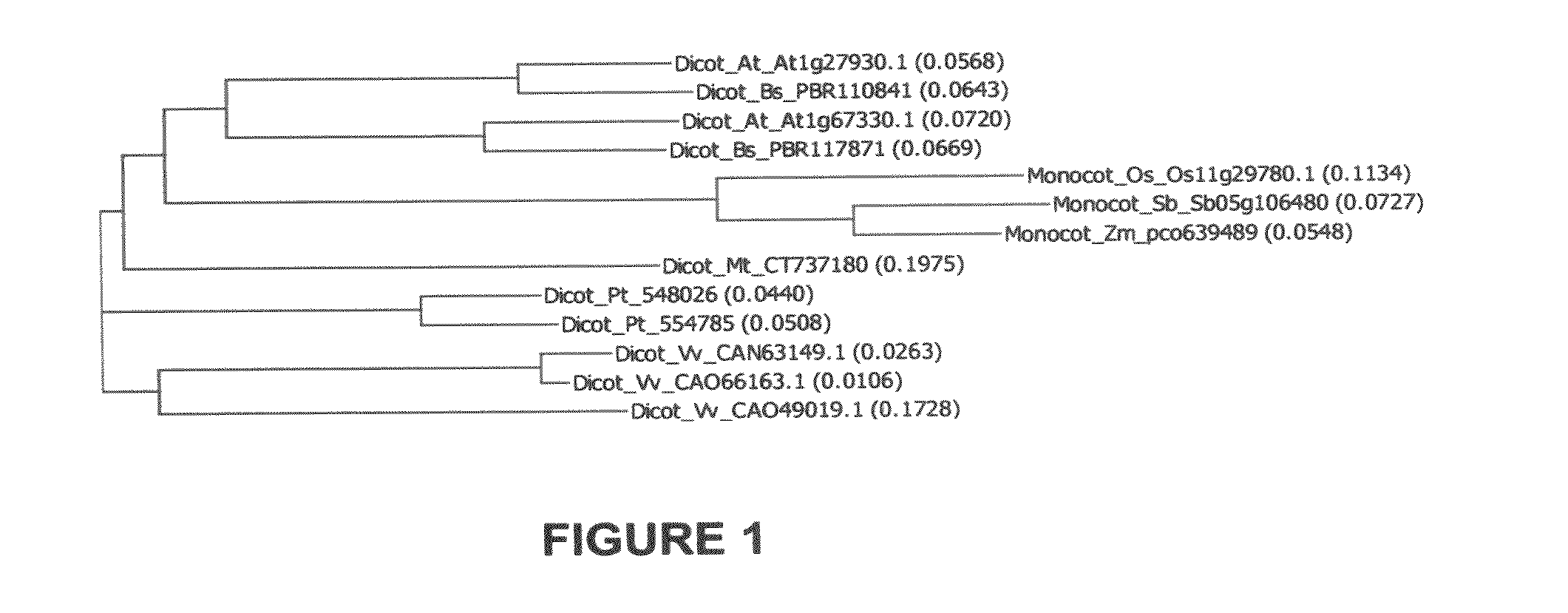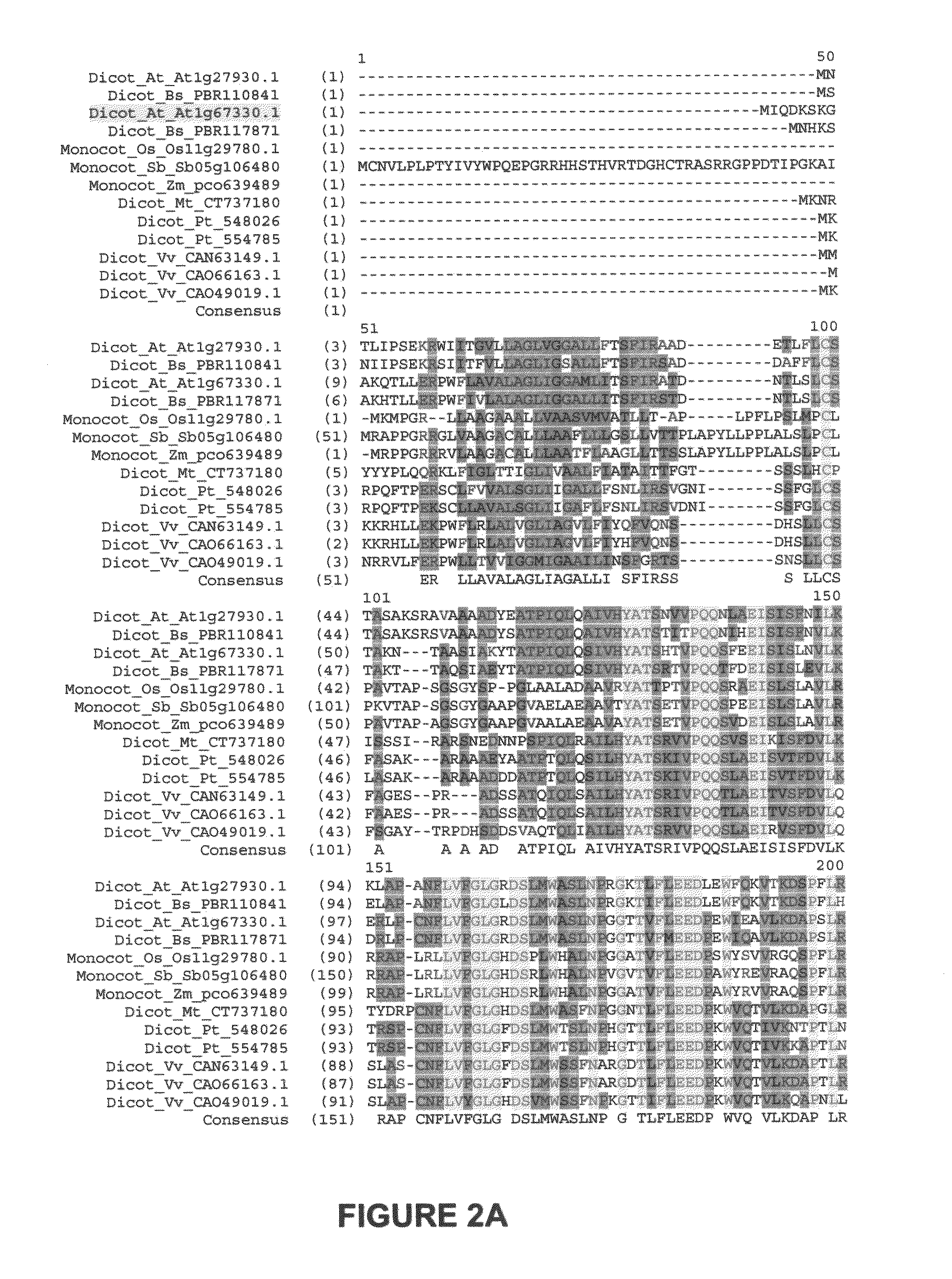Novel At1g67330 gene involved in altered nitrate uptake efficiency
a technology of nitrate uptake and gene, applied in the field of molecular biology, can solve the problems of reducing the environmental impact of nitrogen fertilizer manufacturing and agricultural use, reducing the use and dependence of on-farm input costs, and reducing the level or so as to reduce the level and/or activity of nitrate uptake-associated polypeptides, and reduce the level or elimination of nitrate up
- Summary
- Abstract
- Description
- Claims
- Application Information
AI Technical Summary
Benefits of technology
Problems solved by technology
Method used
Image
Examples
example 1
Creation of an Arabidopsis Population
[0221]A T-DNA based binary construct was created, containing four multimerized enhancer elements derived from the Cauliflower Mosaic Virus 35S promoter, corresponding to sequences −341 to −64, as defined by Odell et al. (1985) Nature 313:810-812. The construct also contains vector sequences (pUC9) to allow plasmid rescue, transposon sequences (Ds) to remobilize the T-DNA, and the bar gene to allow for glufosinate selection of transgenic plants. Only the 10.8 kb segment from the right border (RB) to left border (LB) inclusive will be transferred into the host plant genome. Since the enhancer elements are located near the RB, they can induce cis-activation of genomic loci following T-DNA integration.
[0222]The resulting construct was transformed into Agrobacterium tumefaciens strain C58, grown in LB at 25° C. to OD600 ˜1.0. Cells were then pelleted by centrifugation and resuspended in an equal volume of 5% sucrose / 0.05% Silwet L-77 (OSI Specialties,...
example 2
Screens to Identify Lines with Altered Root Architecture
[0224]Activation-tagged Arabidopsis seedlings, grown under non-limiting nitrogen conditions, were analyzed for altered root system architecture when compared to control seedlings during early development from the population described in Example 1.
[0225]Validated leads from in-house screen were subjected to a vertical plate assay to evaluate enhanced root growth. The results were validated using WinRHIZO® as described below. T2 seeds were sterilized using 50% household bleach 0.01% triton X-100 solution and plated on petri plates containing the following medium: 0.5×N-Free Hoagland's, 60 mM KNO3, 0.1% sucrose, 1 mM MES and 1% Phytagel™ at a density of 4 seeds / plate. Plates were kept for three days at 4° C. to stratify seeds and then held vertically for 11 days at 22° C. light and 20° C. dark. Photoperiod was 16 h; 8 h dark and average light intensity was ˜160 μmol / m2 / s. Plates were placed vertically into the eight center positio...
example 3
pH Indicator Dye Assay to Identify Genes Involved in Nitrate Uptake
[0227]Analysis was performed using the following pH indicator dye assay to identify the genes involved with nitrate uptake as detailed in U.S. patent application Ser. No. 12 / 166,473, filed Jul. 3, 2007. Using the protocol detailed in U.S. patent application Ser. No. 12 / 166,473, filed Jul. 3, 2007, Arabidopsis lines overexpressing At1g67330 with the CaMV 35S promoter or tubulin promoter had significantly less (pArabidopsis lines overexpressing maize pco639489 with the maize ubiquitin promoter had significantly less (p<0.05) nitrate remaining in the medium than wild-type controls.
PUM
| Property | Measurement | Unit |
|---|---|---|
| temperature | aaaaa | aaaaa |
| temperature | aaaaa | aaaaa |
| pH | aaaaa | aaaaa |
Abstract
Description
Claims
Application Information
 Login to View More
Login to View More - R&D
- Intellectual Property
- Life Sciences
- Materials
- Tech Scout
- Unparalleled Data Quality
- Higher Quality Content
- 60% Fewer Hallucinations
Browse by: Latest US Patents, China's latest patents, Technical Efficacy Thesaurus, Application Domain, Technology Topic, Popular Technical Reports.
© 2025 PatSnap. All rights reserved.Legal|Privacy policy|Modern Slavery Act Transparency Statement|Sitemap|About US| Contact US: help@patsnap.com



